North Carolina War Between the States Sesquicentennial
North Carolina Patriots of '61
"Images and Stories of The Old North State's Defenders"
A sampling of the men -- sons, brothers and fathers -- who left their firesides and families to fight for
North Carolina's independence. These are veterans all North Carolinians can rightly be proud of.
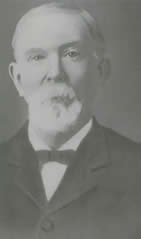
Sergeant Thomas Wood Uzzell
Born 17 June 1844 at his parent’s plantation in Wayne County, near Beston, North Carolina,
Thomas Wood Uzzell was educated in local schools and took the occupation of farmer.
He enlisted on 11 August 1863, probably at Snow Hill in Greene County, in a company formed by
Major John H. Nethercutt of the 8th Battalion, North Carolina Partisan Rangers. Most of the men
of this company were drawn from Onslow, Duplin, Greene, Sampson, Lenoir and Wayne counties and
mustered into Company F of the 8th Battalion on 25 September 1863, Thomas W. Uzzell with the
rank of sergeant. He joined family members in this unit with cousin Jesse Parker Williams holding
captain’s rank and Uncle Mathew Uzzell a corporal.
Initially stationed at Kinston, Uzzell’s unit picketed the roads between there and occupied New Bern
to prevent enemy cavalry from raiding further into North Carolina and disrupting the Wilmington and
Weldon railroad. On 2 October 1863, The 8th Partisan Rangers was transferred into the newly-formed
66th North Carolina Regiment and Sgt. Uzzell assigned to Company I of that unit, comprising part of
Gen. William W. Kirkland’s Brigade.
On 12 October the regiment moved from Kinston to Camp Ashe on Topsail Sound to guard the
New Bern Road above Wilmington; by 21 November it had relocated to Camp Burgwyn nearer to the city
(today, the intersection of Princess Place Drive and 23rd Street).
Under General James G. Martin in late January 1864, Uzzell’s regiment marched up the New Bern Road to
threaten Morehead City and act as a diversion for a main assault on New Bern. The 66th encountered enemy
pickets at Bogue Sound, then fought a sharp two-hour engagement near Newport Barracks. After routing
the enemy, firing stables, storehouses and a railroad bridge, and learning that the attack on New Bern had failed,
the regiment returned to Wilmington.
Sent to Virginia in May 1864 to oppose an enemy offensive against Richmond, and battle at Bermuda
Hundred and Cold Harbor, Sergeant Uzzell was hospitalized in Petersburg mid-June 1864 for an
unspecified complaint, sent to a hospital in Richmond in late June, and furloughed for sixty days on
August 2, 1864. His furlough was extended for thirty days on October 2, 1864, and returned to duty in
time to be sent to Fort Fisher in late December, 1864. There the 66th Regiment fought enemy forces at
the Sugarloaf and Forks Road engagements, withdrew through Wilmington to Duplin Roads, then hard
fighting again at Wise’s Forks, Southwest Creek and Bentonville.
While home on health furlough Thomas Uzzell married Elizabeth “Bettie” Ann Parks (1848-1902) on
21 August 1864 at the Lenoir county home of grandmother Annie Sutton. Bettie was the daughter of Major Parks
and Martha Sutton Parks; the union of Thomas W. and Bettie Ann produced six children between 1866
and 1880: Major, Essie, Thomas, Polly, Atlas and Martha.
Sgt. Uzzell was surrendered with Gen. Joseph E. Johnston’s forces at Durham Station on 26 April 1865.
Older brother Dunn was killed at Manassas and Uncle Mathew died of wounds in May of 1864; Sgt. Uzzell
and father “Big Tom” (1814-1875) drove a wagon to Virginia shortly after the war to retrieve their bodies for
burial at the family plantation.
He and Bettie returned to farming on his father’s property near White Hall (later Seven Springs), on the
Neuse River. Thomas Uzzell supplemented their farm produce with fish and plentiful wild game,
and by 1879 had built a commodious home to house their growing family. Though the war interrupted
Uzzell’s plan to become a lawyer, he later studied law by mail and became a magistrate in
Seven Springs who handled warrants, wills, marriages and minor hearings or trials.
Living fourteen years after losing wife Bettie Ann in 1902, Sergeant Thomas W. Uzzell crossed the river
to rest under the shade of the trees on 28 July 1916, age 71 years.
(Sources: North Carolina Troops, 1861-1865; The Civil War in North Carolina, Barrett; and the Uzzell Family Papers)
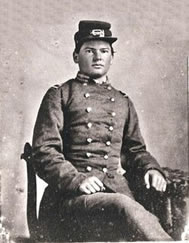
Lt. George McNeil Rose of Cumberland County
“An old and honored name in the annals of Cumberland County is that of Charles G. Rose,
and particularly distinguished at Fayetteville, which has been the family home for a period
reaching back to its early development and covering historic events of State and national importance.
George McNeill Rose was born in Fayetteville on 5 June 1846, the son of John M. and
Jane Strange (McNeill) Rose, the older ancestral line undoubtedly reaching to Scotland and
early settlement in America. In 1860 he became a student in Davidson College and despite the
excitements of public movements and the confusion and discomforts that came about following the
declaration of the war between the States he remained through his freshman and sophomore
years at Davidson, completing his latter year with honors when sixteen years old.
In 1863 he became a student at the Virginia Military Institute, it being his father’s desire to have
his brilliant son complete his education, and as a member of the Cadet Corps of that institution, took
part in the battle of New Market on 15 May 1864, the courage and valor of these schoolboys being
perpetuated in the records of the State’s military history.
In 1864 Cadet Rose enlisted in the Confederate army and was commissioned first lieutenant on
29 October 1864, subsequently becoming adjutant of the Sixty-sixth North Carolina regiment,
Kirkland’s Brigade, of Major-General Robert F. Hoke’s Division, Army of Northern Virginia.
Near Christmas of 1864 Adjutant Rose’s Sixty-sixth Regiment was detached from Lee’s defenses
at Petersburg and sent via rail to Wilmington, North Carolina, to assist in the defense of Fort Fisher
at the mouth of the Cape Fear River. This regiment of 436 officers and men was engaged in the
fighting through both enemy landings and remained entrenched after the fall of the fort.
Regarding the morale of his regiment after the fort’s capitulation, Rose wrote that “living amidst
sand and dirt and on un-sifted corn meal and spoiled Nassau bacon until life became almost
unendurable, but the spirit of the troops never flagged; they were always willing to do their full duty,
and always glad to see the enemy in their front.
The enemy placed segregated black troops in front of Hoke’s position while their white troops
assaulted the fort. Rose wrote further that “Almost every day there would be fighting along upon
the skirmish line [and on 11 February] an attack of considerable force was made upon us by a
[Negro] regiment . . . the fact of seeing those negro troops in front of us exasperated the men
and they fought with great gallantry and easily repulsed the attack . . . “
Lieutenant Rose was with Hoke’s division through the later battle of Forks Road below Wilmington,
during the withdrawal to Duplin Roads, the movement to Kinston to fight at Southwest Creek, and
on to ambush enemy troops at Bentonville. He was paroled near Durham Station with
Gen. Joseph E. Johnston’s army in mid-April.
After the war, Mr. Rose entered the University of North Carolina where he studied law,
and maintained his exemplary scholastic reputation by being salutatorian of the class of 1867.
Upon graduation he established his law practice in the city of Fayetteville and as a trial lawyer
was considered to have no equal in the State. During the last thirty-five years of his practice
he devoted great attention to railroad corporation work, being the representative of the Atlantic
Coast Line Railroad and division counsel over ten counties.
Active all his life in the councils of the Democratic party, Mr. Rose was frequently honored by
this political organization, and thrice elected to represent Cumberland County in the North Carolina
General Assembly, 1877-78, 1881-82, and 1883-84, serving as speaker pro tem of the
House of Representatives in the 1881-82 session, and as speaker in the session 1883-84.
In public life he proved high-minded and honorable as in his profession, and it is certain that few men
of his time and public consciousness ever commanded more respect or enjoyed more public esteem.
He was a trustee of the University of North Carolina, a trustee of the First Presbyterian Church of
Fayetteville, major and commander of Camp No. 852, United Confederate Veterans at Fayetteville,
and at the time of his death, 15 June 1924, was Chairman of the Board of Trustees of the Confederate
Veterans Widows’ Home at Fayetteville.
Rose authored the History of his Sixty-sixth North Carolina Regiment in Judge Walter Clark’s
“Histories of the North Carolina Regiments,” published in 1901.
For more than fifty years he was a member of the Order of Odd Fellows, and it was, perhaps,
one of the most pleasurable occasions of his closing years when he was presented with the
Veterans Jewel, and emblem testifying to his half-century membership.
On 16 December 1869 he wed Augusta Jane Steele and their union was blessed with eight children,
one of whom, Charles G. Rose, is his eminent father’s successor as a leader of the Fayetteville bar.
Son Charles G. was a graduated from the University of North Carolina Law School and joined his father
in practice in the style of Rose & Rose, which continued to his father’s death in 1924. He later formed
a partnership with Terry A. Lyon, and continued in his father’s work as Atlantic Coast Line Railroad legal counsel.
Sources:
North Carolina Troops, 1861-1865, Volume XV;
North Carolina, Rebuilding an Ancient Commonwealth, Volume III, American Historical Society, 1928, pp. 64-65
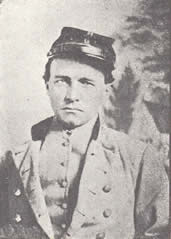
Captain Peter M. Mull of Catawba County
“Capt. Peter M. Mull, the son of Jacob and Mary Mull, was born July 11, 1832. He came from good old Dutch
stock, the Mulls from Holland being the first settlers of Catawba County. His early life was spent on his Father’s
farm, where he worked and attended the county schools; and in 1855 he was a student at Catawba College.
When the war broke out, he volunteered and went for six months in Capt. Wm. Hoke’s Company, of Lincolnton and
was in the first battle fought at Bethel Church; and when his time of enlistment expired, he came home and the following
spring, made up a company and was elected Captain April 19, 1862, and returned to the Confederate army, where he
served until a few days before the surrender, being furloughed home on account of physical disabilities caused
by a severe wound.
On Sept. 6, 1862, when in command of two hundred picked men at Washington, N.C., he was twice wounded,
in the head, and shot through the left lung, the latter wound almost causing his death. A few months after the war
was over, Capt. Mull went to South Carolina and hauled supplies for the R.R. Co., the road then rebuilt from Columbia
to Winnsboro. He also run a stage coach. After staying in South Carolina for eighteen months, he returned to
Catawba County and bought a farm, and improved the old Mull mill, and engaged in farming and milling.
In August, 1888, he married Miss Alice Yount, and in 1895 moved to Newton where he now resides. He has always
been charitable and warmhearted, and a devoted Christian, and is known for his great love of truth, honesty and sincerity.”
(The Catawba Soldier of the Civil War, George W. Hahn, Clay Printing Company, 1911, pp. 312)
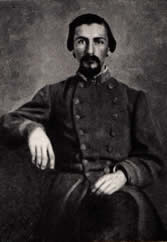
Major William Rufus Rankin of Gaston County
On October 6, 1861, the “Gaston Blues” gathered and formed a company. They elected 38 year old Gaston County
native William R. Rankin as Captain. The company was mustered into State service on 20 November 1861, and
assigned as Company H, 37th Regiment, North Carolina Troops. All these men were farmers, along with many of
the 93 men who enlisted that day in Gaston County. Appointed major on 27 March 1862, Rankin was assigned
to the Field and Staff.
The 37th North Carolina Regiment saw action in New Bern, Hanover Court House, Gaines’ Mill, Frazier’s Farm,
Second Manassas, Ox Hill, Sharpsburg, Fredericksburg, Chancellorsville, Gettysburg, Petersburg and Appomattox.
(Thirty-Seventh North Carolina Troops, Michael C. Hardy, McFarland & Co., 2003)

Brigadier-General Thomas F. Toon of Columbus County
Born on June 10, 1840 in Columbus County, Thomas Fentress Toon was a farmer prior to attending Wake Forest
College, rising to the senior class at that school when he joined the Columbus Guards No. 2 on May 20, 1861.
He returned to Wake Forest to graduate in June 1861 and then rejoined his company.
The Columbus Guards had been raised in Columbus County and assigned to Company K of the 20th North Carolina.
Toon mustered in as a private, elected Lieutenant on June 18th, then Captain to rank from July 22nd.
A fellow captain in the regiment was his kinsman William H. Toon of Bladen County, who eventually rose to
Lieutenant-Colonel of the regiment.
Shot by the enemy twice in 1862, he would end the war wounded a total of seven times and fought with conspicuous
gallantry at Seven Pines, the Seven Days Campaign, South Mountain and Fredericksburg. Toon was elected
colonel of the regiment on February 26, 1863 when his seniors in rank waived their own rights to promotion.
He led the 20th North Carolina Regiment during Stonewall Jackson's famous flank attack at Chancellorsville and
was shot three times while leading his regiment through what he later described as "a perfect storm of shells and
a mist of minie balls." He later returned to duty and sustained wounds twice more before the end of the war.
His regiment was heavily involved at Gettysburg from July 1-3, 1863, and his 20th North Carolina suffered horribly
during the first day’s action with 65% casualties; and later the Mine Run Campaign and the bloody battles of the
Wilderness and Spotsylvania. When General Robert D. Johnston (of Lincoln County) was wounded at Spotsylvania,
Colonel Toon was promoted to the rank of brigadier general to date from May 31, 1864. He commanded the brigade
during Gen. Jubal Early's Shenandoah Valley campaign and threatening advance on Washington City.
Colonel Toon received his last and most serious wound on March 25, 1865 during the assault on Fort Stedman,
near Petersburg. He was sent to a hospital in Greensboro, North Carolina on April 7th and recovered sufficiently
to be present when General Joseph E. Johnston surrendered his army at the end of the month.
Colonel Toon returned to Columbus County after the war and served as principal at Fair Bluff School, and was
a vocal advocate of public education in North Carolina. Toon was elected to the position of North Carolina
Superintendent of Public Instruction in 1901. General Toon died in Raleigh on February 19, 1902, and is buried in
that city in Oakwood Cemetery. Thomas F. Toon was honored with a State Historical Marker at Fair Bluff on
August 26, 2000 and official ceremony by the NC Sons of Confederate Veterans of Columbus County.
(Cape Fear Historical Insititute Historical Essays, www.cfhi.net)
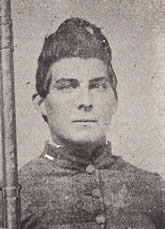
George W. Hahn of Catawba County
Professor George W. Hahn…enlisted in the Southern army Aug. 1, 1861. At Gettysburg he was twice wounded,
and to save himself from mutilation, he improvised a breastwork of the biggest corpse at his side – a dead, fat, Yankee,
and here remained until the enemy were driven back. On his return from Appomattox ragged and dirty – all his clothing
having been sent him at different times during the war – his mother and sisters set to work to provide clothing for their
three returned boys. On the way home through Greensboro, N.C. they snatched a piece of gray cloth. Out of this
and an old yellow Yankee tent, a suit was made for each and for respectable shirts their sister gave a blue fadeless
calico dress. With these provisions they were enabled to go and see their neighbor.
(The Catawba Soldier of the Civil War, George W. Hahn, Clay Printing Company, 1911, pp. 204-205)
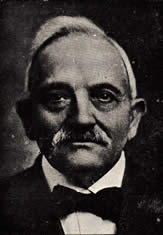
J. Sidney Setzer of Caldwell County
“I enlisted at Newton, NC, in August 1861. We were the First NC Battalion; later Company A, 32nd Regiment.
I was not the bravest of the brave, though participated in every engagement of my regiment engaged in (until captured).
Beginning with a slight skirmish at Winston, NC, the battles of Gettysburg, Wilderness and Spottsylvania Court House
being the most disastrous. During the three days battle at Gettysburg I witnessed about eight men in hand to hand
struggle over a Federal flag, using butts of guns; one Confederate soldier only securing it.
Confronting Heights [the] third day, in front of [a] Battery, and small arms, I witnessed a number of our men torn
asunder, threads of flesh thrown into low limbs of overhanging trees. We were on the banks of a deep ravine at edge
of woods, the front being a steep field, and our only refuge was falling into the ravine, [we then] crawl[ed] to the
left to front cover of woods, when we charged and dislodged the enemy for a time.
At dusk, when both armies began to retreat, I was on skirmish between the two and was slightly wounded,
but remained with the command. Our retreat re-crossing [the] swollen Rappahannock, struck us under arms,
compelling us to cling in groups of fours to avoid washing down[river].
After hard battles of [the] Wilderness to Spottsylvania Court House, half or more of our survivors were captured,
including myself. The loss of life was appalling. Our captors, nearly drunk, howled “no quarter.” Interference of their
officers saved us from massacre. We were rushed through their six lines of battle over more dead than I ever witnessed
elsewhere. We were conveyed to Point Lookout, Md.; later to Elmyra, N.Y., suffering untold destitution at both places.
I was paroled February 25, 1865, and sent to Richmond, and from there home. Was not exchanged, consequently was
at home when the war ended. The hardships, dangers, etc., of the four years were almost intolerable.
After returning home I engaged in farming and school teaching in the common schools for a few years. Having no means
to begin with in the way of money or inheritance of property, I bought a small farm in Caldwell County on credit. Was
married and settled down where [my] wife and I labored together on the little farm until it was paid for. Then bought some
interest in cotton mill, etc., in Granite Falls, NC, where I worked on salary and accumulated [savings).”
(The Catawba Soldier of the Civil War, George W. Hahn, Clay Printing Company, 1911, pp. 211-212)
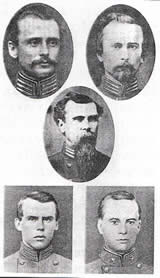
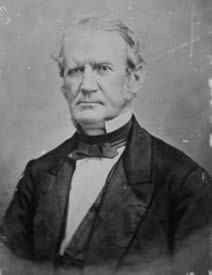
Sons of Governor William A. Graham of Orange County
Pictured above left are Graham’s five sons who served North Carolina and the Confederacy.
Top from left: Captain Robert D. Graham, Captain James A. Graham; Captain Joseph Graham (center);
(bottom from left) Major William A. Graham, Jr., and Major John W. Graham.
Former Governor (1845-1849), United States Senator (1840-1843), Secretary of the Navy (1850-52), and 1852
vice-presidential candidate with Winfield Scott, William A. Graham gave five of his sons to fight for North Carolina’s
independence. He served as a State senator 1854-1866, and member of the Confederate Congress 1864-1865.
Major John W. Graham organized Company D of the 56th North Carolina Regiment, with brother and fellow officer
Captain Robert D. Graham in the company as well. The 56th North Carolina fought through the battles of Gum
Swamp, Plymouth , Drewry's Bluff , the Petersburg trenches south of the James River, and Appomattox.
Captain Joseph Graham served with the Charlotte Artillery, Company C, 10th North Carolina Troops. This battery
participated in the many battles in of the Army of Northern Virginia – across Virginia, Maryland, Pennsylvania
and North Carolina.
Major William A. Graham fought with Company K, 2nd North Carolina Cavalry, seeing action around New Bern,
Kinston and Washington; Fredericksburg, Brandy Station, Hanover, Gettysburg, Hanover Court House, Haws Tavern,
Wilson’s Farm, Hampton’s Cattle Raid, Five Forks, and Appomattox. After the war he served as a State senator
and State agricultural commissioner.
Captain James A. Graham commanded Company G (Orange Guards), 27th North Carolina Regiment under
Col. John R. Cook. A student at Chapel Hill when he entered service in April 1861 in the Orange Guards, his unit
saw action at New Bern, Sharpsburg, Wilderness (severely wounded), Fort Euliss, Harper’s Ferry, Bristol Station,
Hatcher’s Run, Mine Run, Southerland’s Tavern and Appomattox.
(Captain James A. Graham, Confederate Veteran, Volume 4, 2002, pp. 42-44)
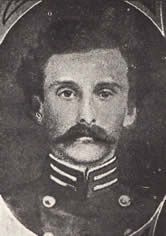
Lieutenant J.P. Little of Catawba County
“J.P. Little enlisted in Company C [28th Regiment], at Newton on August 13, 1861. He was at this time only
sixteen years oif age, and the examining officer, thinking the boy too young to enlist, refused to accept him at
first but through persistent pleadings of the youth to fight for a cause that he thought was just, he was at length accepted.
Even at this early age he was cultivated to no small degree. His manners were frank and candid, and the more
intimately he was known, the better he was beloved. Never was he known to shrink from any toil, however painful,
nor quail before any danger.
He had a high regard for his superior officers, and more still for the commission which he filled, as exemplified in an
anecdote told be one of his comrades. At the Battle of the Wilderness when the soldiers had become somewhat routed,
in order to rally them again the brave Captain Lovell reached up to shake the flag that Little was carrying, but the
fearless ensign, reaching for his pistol, gave the Captain to understand that he was man enough to carry that flag and
for him to let it alone.
He was in many of the principal battles of the war, namely, Hanover Court House, Seven Days…around Richmond,
Cedar Run, Second Manassas…Oz Hill, Harper’s Ferry, Sharpsburg…Shepardstown, Fredericksburg, Chancellorsville,
Wilderness, and Spottsylvania Court House. At the Battle of Frazier’s Farm he received a wound in the thigh, and was
also wounded at Chancellorsville, and Spottsylvania Court House. At the latter place he was in the famous Bloody Angle
and was taken a prisoner here. Later he was sent to Elmira, New York, where he was held during the remainder of the war.
He returned home in the summer of 1865, and then completed his education. He is now a merchant in Hickory.”
(The Catawba Soldier of the Civil War, George W. Hahn, Clay Printing Company, 1911, pp. 174-175)
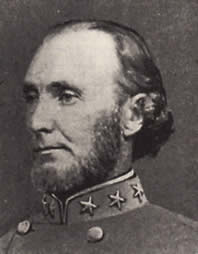
Colonel Dennis Dozier Ferebee of Currituck County
The son of Samuel and Margatte “Peggy” Dauge (Dozier) Ferebee, Dennis Dozier Ferebee was born on
November 9, 1815 in Currituck County. Graduating from the University of North Carolina at Chapel Hill
in 1839, he married Sarah McPherson on February 3, 1842. After studying law under Judge William Gaston
of New Bern, Ferebee became a Camden County lawyer, planter and politician prior to the war, serving as a
member of the State legislature and later county delegate to the May 1861 North Carolina Secession Convention.
Though a stauch Unionist, he voted for North Carolina’s secession after Lincoln’s decision for war against
the South. As Colonel of Camden’s local militia, the 2nd Regiment of the 1st Brigade, he saw action at the
battle of South Mills in Camden County in April 1862; in August of that year he was appointed Colonel of the
4th North Carolina Cavalry. Ferebee was wounded in the foot at Bristoe, Virginia in 1863; absent/wounded through
April 1864, and resigned from service on March 7, 1865 – serving on Governor Zebulon Vance’s staff until the
close of the war.
Colonel Ferebee was a prominent member in the 1865 State Convention working with Governor Jonathan
Worth to reopen the University. He was described as having “distinguished appearance and elegant manners” and
exemplified “what a gentleman should be.” He died in Camden County on April 26, 1884 and is buried on Hodges
Farm, McPherson Road, Camden County.
(4th North Carolina Cavalry in the Civil War, Neil Hunter Raiford, McFarland & Co., 2003)
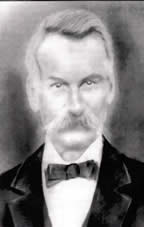
C.A. Bumgarner of Alexander County
Christian (or Christus) Augustus Bumgarner was born in Alexander County in 1846, son of Simon and
Eliza Bumgarner of Sugar Loaf Township. When war broke out his older brothers David L. and Tobias, both
farmers, enlisted in “the Alexander Men” which became Company G, 37th North Carolina Infantry Regiment.
The 37th Regiment was engaged at first New Bern and then in Virginia from Hanover Court House through
Cold Harbor to Appomattox. Brother David was killed at Gaines Mill in July 1862; brother Tobias died
of typhoid fever a month later.
Christian enlisted at the age of 17 in October 1863, joining Company A of the 56th North Carolina Infantry.
This unit was mustered at Camp Mangum near Raleigh in July 1862 under Colonel Paul F. Faison, with further
calls for recruits in Rutherford, Mecklenburg, Alexander, Camden and Cumberland counties.
Christian’s company was detailed to North Carolina guard and reconnaissance duty and monitoring Northern raids
emanating from New Bern. The 56th Infantry also saw battle duty as part of General Matt Ransom’s brigade which
fought at Gum Swamp, Plymouth, Drewry’s Bluff, Ware Bottom Church, Sayler’s Creek, Petersburg, and the retreat
to Appomattox. At the latter the unit mustered only nine officers and sixty-two enlisted men in the ranks.
C.A. married Julia Catherine Daniels in 1867, settling into home in Sugar Loaf. He died at age 84 and is buried in
the old churchyard of Salem Lutheran Church. His descendants are still to be found in the Taylorsville
region of Alexander County.
(C.A. Bumgarner, John F. Crossen, Confederate Veteran, Sept/Oct 2003, pp. 16-17)
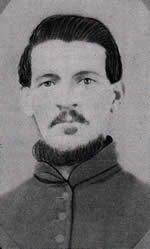
Private J.T. Prickett of Granville County
J.T. Prickett enlisted as private in the “Granville Stars” at age 21, on 17 June 1861. He and his local compatriots
mustered in at Oak Hill for 12 months, and additional recruits were sworn in at Garysburg in Northampton County.
The Granville Stars initially became part of the 13th Regiment, North Carolina Troops, and later Company I,
23rd North Carolina Troops. Prickett’s unit was sent by rail to Manassas for the July 21 battle in Virginia, but was
not engaged due to train delays. Placed under Colonel Jubal Early’s command, they were brigaded with the 5th and
21st Regiments, North Carolina Troops and the 24th Virginia.
Camp illness struck down many of the soldiers in these units and kept them idle. Private Prickett and his 13th was
moved to Fairfax Station in early August – then to Union Mills in September for picket duty. It was here in mid-November
that the unit designation was officially changed to the 23rd Regiment, North Carolina Troops.
Private Prickett died on 14 December 1861, exact cause of death was not reported but probably as a result of the
many camp diseases – he was one of over 20,600 North Carolinians who would perish from disease during this
war for Southern independence.
(Confederate Images, C.E. Avery, Confederate Veteran Magazine, July/August 2003, page 14)
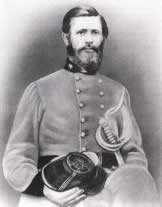
Colonel Samuel H. Walkup of Union County
Samuel Hoey Walkup was born 22 January 1818, the fifth son of Robert and Elizabeth Johnston Hoey Walkup,
in Jackson Township, Union County. He graduated from the University of North Carolina in 1841, went on to practice
law in Monroe, was elected to the North Carolina Legislature, served in the office of Solicitor for the Court of Common
Pleas, and then the State Senate. During this time he was an officer in the North Carolina Militia,
Captain of “the Waxhaws No. 2.”
He married Pamelia (Minnie) Reese Price of Steele Creek in October 1860; she was an accomplished pianist
who was invited to entertain President James Buchanan and guests at a White House reception. Samuel’s grandfather,
Captain James Walkup, was a Revolutionary War officer serving under Colonel William Davie.
Samuel was elected Lt. Colonel of the 48th North Carolina Infantry, mustered into service on 15 May, 1862, at
Camp Mangum near Raleigh. He was second in command to Colonel Robert C. Hill, of Iredell County; Benjamin
R. Huske of Cumberland County was major. The 48th North Carolina was attached to General Robert Ransom’s brigade
in Virginia, and saw action against Northern gunboats on the James River, Seven Days’ Battle, Sharpsburg and
Fredericksburg, the latter where Walkup was wounded in the hip. Further fighting was seen at Bristoe Station,
and a promotion to Colonel on 4 December after the death of Colonel Hill.
In early April 1864, Colonel Walkup and his 48th North Carolina fought desperately to repulse repeated Northern
assaults at the Wilderness battle where he was wounded again. More action awaited his unit at Spotsylvania
Courthouse, Cold Harbor, and the Petersburg Campaign. At Appomattox Court House on April 9. 1865, the
100 remaining men of the 48th North Carolina stacked their arms, and Colonel Walkup walked home to Monroe.
Walkup was elected to the United States Congress in November, 1865, but the Radical Republican Congress refused
to seat him as he would not repudiate his Confederate service. He later was elected Clerk of Court in Union County,
and served as a Trustee for the University of North Carolina. Colonel Walkup died of chronic dysentery brought on
by his poor diet in military service, passing on 26 October, 1876. He is buried in Suncrest Cemetery in Union County.
(Dissident Colonel of the 48th NC Infantry, Gerald Starnes, Confederate Veteran, 1/2005)
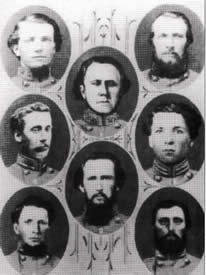
The Officers of the Thomas Legion:
Colonel William Thomas top-center; Lt. Colonel James R. Love lower center;
Major William W. Stringfield top left; Lt. Robert T. Conley center-right.
The Thomas Legion was formed to defend the mountainous region of North Carolina, eastern
Tennessee and southwest Virginia from Northern invasion.
William Holland Thomas was born in 1805 in Waynesville and was 56 years old when the war began. A successful
businessman and veteran North Carolina legislator, Thomas recruited mountaineers and Cherokee Indians near
Waynesville, many of whom he had known since childhood.
At the age of twelve, Thomas had been adopted by Yonaguska, chief of the Oconaluftee tribe of the Cherokee
Nation, and given the name of Wil-Usdi, meaning “Little Will.” A successful merchant and trader, by 1861 Thomas
had amassed 34,000 acres of land and was one of western North Carolina’s largest landholders. His first
company of Cherokee volunteers was named the “Junaluska Zouaves,” and on April 9, 1862 the unit was mustered
into Confederate service at Qualla Town by Major George Washington Morgan, an Indian, with William
Thomas serving as captain.
Thomas petitioned Governor Zebulon Vance to authorize a guerilla force of his own selection in North Carolina,
and adopted the name “Highland Rangers.” By late September 1862 he had raised an 1100-man regiment,
which included two companies of Cherokees. Their first assignment was to round up deserters and men fleeing
from conscription, and later saw action in east Tennessee. In a fierce counterattack against Northern forces,
Lt. John Astooga Stoga was killed, and his enraged braves reportedly scalped Northern soldiers who fell into their hands.
In the late fall of 1862 the Legion was sent to Madison County to suppress Yankee bushwhackers in that area; by
spring 1863 the Thomas Legion had added Levi’s Light Battery of artillery, and had grown to an 2800 man force.
In the Battle of Limestone Station, Major William C. Walker’s battalion of the Legion captured 314 Northern prisoners;
shortly thereafter Lt. Colonel J.R. Love’s 600-man regiment charged the 5th Indiana Cavalry who fled the field in
disorder. Love’s men would fight under General “Grumble” Jones at Piedmont in early June, 1864; then under
General Jubal Early’s command for the 1864 Shenandoah Valley Campaign. Though battle wounds and death had
diminished the ranks by March 1865, more recruiting had brought the Legion up to 1200 effectives. By May of 1865,
the Thomas Legion was the only Southern unit east of the Mississippi that had not capitulated to Northern forces.
Having surrounded a Northern mounted infantry unit with the Cherokee battalion and Love’s regiment near Waynesville
on May 10th, the Legion disbanded and returned to their nearby homes and farms. Thomas was bankrupted by the
war and spent most of his postwar life in asylums; he died on May 10th, 1893 in Morganton. Seen below is the
1901 Reunion of Cherokee survivors of the Thomas Legion.
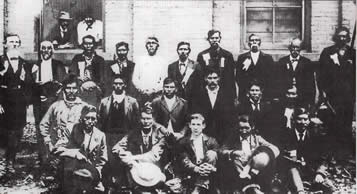
(The Thomas Legion of North Carolina, Bob Broadwater, Confederate Veteran, Vol. Two, 1997)
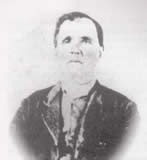

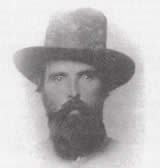
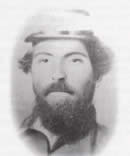
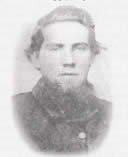
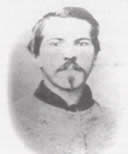
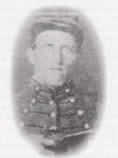
Caldwell County’s Captain William Deal, III -- and Six Sons:
Born 14 August 1798 in Lincoln County, William Deal, III was the descendant of German settlers from
Pennsylvania’s Palatinate Immigrants who bought cheap and abundant land in western North Carolina.
Deal married Catherine Smyre in 1824 and their union produced twelve children – six sons and six daughters.
The Deal Plantation was located on Clark’s Little River in Cedar Valley, Caldwell County, where William operated
a country store, grist mill, woodworking, harness, saddle and blacksmith shop. In 1836 a United States Post Office
was located in his store and the plantation became known as Deal's Mill, North Carolina.
First son (in order above) William Franklin Deal enlisted in 1862, working for the Supply Depot in Salisbury.
Sidney Deal joined the Watauga Rangers in 1862 -- Company D, 1st North Carolina Cavalry. Pinckney, Marcus and
Rufus Deal all enlisted in the Caldwell Rough and Ready Boys which became Company A, 22nd North Carolina.
Youngest son Avery Jerome Deal enlisted in Company A, 22nd North Carolina in 1863 at the age of 19.
Rufus served with the 22nd North Carolina until January 1864, he was then then appointed lieutenant of
Company I, 26th North Carolina (Caldwell Guards). He was killed in action at Cold Harbor. Father William
journeyed by wagon to tidal Virginia to retrieve his son's body for burial at home.
While his sons were away at the front, father William enlisted in the Caldwell County Home Guard in 1861
at age 61, and promoted to captain in 1863. Daughter Harriet scalded a marauding Northern soldier with hot water
in early 1865 as he made off with her setting hen from the chicken house.
(A Father and Six Sons Who Served, Robert C. Deal, Confederate Veteran, Vol. III, 2002)
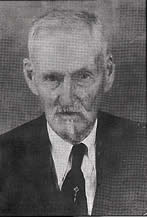
Corporal Charles Skinner Riggan – Warren County
The son of Jerry and Mary Johnson Riggan, Charles was born 27 October 1842 at Vaughan, North Carolina.
He enlisted at age eighteen on 16 August 1861 at Littleton, and joined Company B, 30th North Carolina. That unit
was organized at Camp Mangum on 7 October of that year, sent to Weldon first, then to Wilmington, and on to
Richmond to join Anderson’s Brigade. He was in the fighting at Chickahominy, Chancellorsville, and took shrapnel in
his right arm at Spotsylvania in May 1864. He returned to duty quickly and received a shoulder wound at Cedar Creek,
the last major engagement in the Shenandoah Valley. Corporal Riggan was among General Lee’s Tarheels
at Appomattox on April 12, 1865.
Corporal Riggan was active in postwar United Confederate Veterans reunions, and Wellman’s History of Warren County
shows him in a group photo with twenty other North Carolina veterans at the 27 August 1903 dedication of the Warrenton
Cemetery Confederate monument. “Uncle Charlie” danced well into his eighties, smoked cigars moderately, and the
Warrenton United Daughters of the Confederacy held a grand reception in honor of his 100th birthday. He was
presented with the Southern Cross of Honor on 30 May 1945 by the Pickett-Buchanan Chapter, UDC in Norfolk, Virginia.
Corporal Riggan crossed the river to join his comrades in grey on 26 March 1947.
(Source: Charles Skinner Riggan, Prof. Jay S. Hoar, Confederate Veteran, Volume Two, 1997)
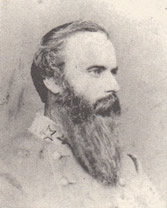
Colonel William Lee Davidson of Mecklenburg County:
Colonel Davidson was born at Oak Lawn plantation in Mecklenburg County 10 February 1825, son of Benjamin Wilson
and Elizabeth Latta Davidson. He attended Davidson College, named for relative Brigadier-General William Lee Davidson
who was killed fighting the British at Cowan’s Ford, North Carolina in 1781.
He was a Mexican War veteran and a merchant before 1861. At the outbreak of war with the North, Davidson
was elected Captain of his Mecklenburg company on 16 May 1861, mustered as Company D, 7th North Carolina
Regiment at Camp Mason in Graham in August 1861. He was promoted to Major 24 February 1863; and
Lieutenant-Colonel on 3 May 1863. The 7th North Carolina included men from Iredell, Alexander (Alexander State
Troops), Cabarrus (Cabarrus Minute Men), Rowan, New Hanover, Mecklenburg, Nash (Stanhope Tiger Guards)
and Wake (Wake Rangers) counties. The regiment saw action at New Bern, Hanover Court House,
Seven Days’, Second Manassas, Ox Hill, Sharpsburg, Chancellorsville, Gettysburg, Cold Harbor, Wilderness,
Spotsylvania, and Appomattox
Colonel Davidson was wounded in action at Chancellorsville, wounded again at the Wilderness, captured by the enemy
at the latter. Exchanged in August 1864, he was promoted to Colonel on 28 November 1864 and was paroled on
15 May 1865 in Charlotte.
Living in Kentucky, Tennessee, South Carolina and Lincolnton, North Carolina in the postwar, Colonel Davidson worked
as a lawyer and clerk for several railroads. He married Anne Irvine in 1870, died in Chester, South Carolina
13 August 1899. He is buried in St. Luke’s Episcopal Cemetery in Lincolnton.
(Source: Confederate Colonels, Bruce S. Allardice, University of Missouri Press, 2008)
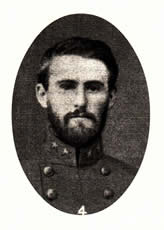
Colonel William M. Parsley of New Hanover County
William Murdock Parsley was elected Captain of the Cape Fear Riflemen in April, 1861, a company he helped form
in the fall of 1860. His father, banker Oscar G. Parsley, completely uniformed and equipped the unit out of his own
pocket. Captain Parsley and his men were among those who occupied Fort Caswell at the mouth of the Cape Fear
River after word reached Wilmington of President Buchanan’s “Star of the West” armed expedition against Fort Sumter
in January, 1861. Local patriots feared that Northern seizure of Fort Caswell would seal off the port of Wilmington
as the British had done during the Revolution.
In June, 1861 the Cape Fear Riflemen were ordered to Virginia as Company F, Third North Carolina Regiment and
participated in the battles at Mechanicsville, Seven Days’, and Malvern Hill where Captain Parsley was severely
wounded in the neck. He quickly returned to duty and fought in every battle of the regiment through Sharpsburg.
Promoted to Lieutenant-Colonel at the beginning of Lee’s Pennsylvania Campaign in 1863, he led the
Third North Carolina in the successful assault up Culp’s Hill at Gettysburg on the third day. In that action, every officer
of the old Cape Fear Riflemen was killed, and Parsley had received two slight wounds and a narrow escape with death
by a glancing minie ball.
Leading the regiment once again at Spotsylvania Court House in May 1864, Parsley was in the desperate hand-to-hand
fighting at “Bloody Angle” and suffered capture, then sent to Fort Delaware. From that confinement, he and fifty Southern
officers were sent on the prison ship Dragon to Morris Island, South Carolina and placed as human shields in front of
Northern batteries shelling civilians in Charleston. In addition to being exposed to the fire from their own compatriots,
the officers were systematically starved with many dying of intestinal disorders brought on by scant and wormy rations.
Parsley was one of the fortunate few who were exchanged in August, 1864, and returned to the Third North Carolina
with a few recruits from Wilmington. In the engagement at Sailor’s Creek during the Army of Northern Virginia’s
retreat to Appomattox, twenty-four year-old Lt-Col. Parsley was killed by a Northern sharpshooter’s minie ball,
falling with his face to the enemy.
(Source: Chronicles of the Cape Fear, James Sprunt, Edwards & Broughton, 1916, pp. 297-299)
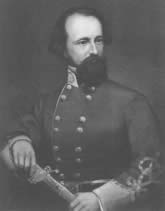
Brigadier-General James Johnston Pettigrew of Tyrrell County:
Born on the 4th of July, 1828 at Bonarva plantation, Tyrrell County, the supremely gifted James Johnston was
the son of accomplished planter Ebenezer Pettigrew who also owned nearby Belgrade and Magnolia plantations.
James attended Bingham Academy in Hillsborough and entered the University of North Carolina at age fifteen,
graduating with a perfect academic record. His scholastic career was so brilliant that upon his graduation in 1847,
President James Polk tendered his appointment as assistant professor at the Naval Observatory in Washington,
under acclaimed scientist Matthew F. Maury.
In 1849 Pettigrew left for Europe where he earned a civil law degree from the University of Berlin; and toured extensively
in Germany, France, Italy, Spain and the Austro-Hungarian empire. He returned to Charleston in 1853 and served as
the junior partner of James Louis Petigru. James was elected to the South Carolina General Assembly in 1856, and
wrote a celebrated report against the reopening of the foreign slave trade.
He returned to Europe in 1859 to enlist in the Sardinian army during the Franco-Austrian war, though
unsuccessfully. He returned to Charleston and was in command of South Carolina’s First Regiment of Rifles from
December 1860 to the capitulation of Fort Sumter. He subsequently enlisted in the Hampton Legion, was
elected colonel of the 12th South Carolina Regiment, and by July 1861 was in command of the
22nd North Carolina Regiment.
Pettigrew’s field officers in this regiment were Lt.-Col. John O. Long of Randolph County, and
Major Thomas S. Galloway of Rockingham County, and the men enlisted from Caldwell, McDowell,
Guilford, Alleghany, Stokes, Caswell and Randolph counties.
Promoted to brigadier in March 1862, Pettigrew formed a brigade composed of Col. Collette Leventhorpe’s
11th North Carolina; the 44th North Carolina under Col. Thomas Singletary; the 47th North Carolina under
Col. George H. Fairbault; Col. James K. Marshall’s 52nd North Carolina; and the 26th North Carolina, the
regiment of Col. Zebulon Vance before he had been elected governor. The commander of the 26th was
twenty year-old Col. Henry King Burgwyn, Jr., one of the youngest and most able colonels in the
Southern army. Pettigrew led this brigade at the battle of Seven Pines where he was wounded and captured,
imprisoned at Fort Delaware, and exchanged.
Joining the Army of Northern Virginia in early June, 1863, Pettigrew’s Brigade successfully assaulted McPherson’s
and Seminary ridges at Gettysburg on the first day, and sustained great casualties. General Pettigrew led
(General Henry) Heth’s Division during Pickett’s assault on the third day. During Lee’s movement after Gettysburg,
Pettigrew was wounded for the fifth time, fatally, in a rearguard action on the Potomac with Northern cavalry.
He died on 17 July.
A friend said of Pettigrew: “More than all he loved liberty…but he felt that to love liberty was an empty mockery,
unless that love was exhibited in the sacrifice which its acquisition requires. With him to be free, was to be prepared
for and to engage in the struggle it demands.” Another said: “He was my beau ideal of what a gentleman and
a soldier ought to be.”
Matthew Fontaine Maury wrote of him after the war: “I considered Pettigrew the most promising young man
of the South, and, as young as he was, I advocated for him the post of our Generalissimo.”
General Pettigrew’s body was taken to Raleigh where, on 24 July, it lay in state in the capitol, surrounded by
wreaths, weaved by the fairest ladies, of flowers from the fairest gardens in the town. Buried temporarily in Raleigh,
his remains are now at home at Bonarva, in the family burial ground adjacent to Lake Phelps.
(Source: Carolina Cavalier, Clyde N. Wilson, Chronicles Press, 2002)

Captain John Newland Maffitt:
Born at sea on 22 February 1822 enroute with his parents from Ireland to New York, Maffitt was predestined
for life as a sailor. At the age of five, uncle Dr. William Maffitt, brought him to Fayetteville, North Carolina due to
his parents dire financial straits; at about nine or ten years he was sent for schooling at White Plains, New York
under Professor Swinburn. Thanks to friends of his father, thirteen year-old Maffitt acquired a midshipman
commission to the US Navy, with first orders to the USS St. Louis, then at Pensacola.
A task that marked his later years of service was being posted to the US Coast and Geodetic Survey
in 1842 under the eye of Professor Bache, and surveying the harbors of Nantucket, Wilmington, Savannah
and Charleston – a channel at the latte still bears his name.
Commanding the USS Dolphin in 1857 and USS Crusader, 1859-1861, Maffitt captured New York-financed
slavers bound for Spanish colonies in the West Indies – slaves bartered for with New England rum.
Maffitt resigned his commission in May 1861 and became a lieutenant in the Confederate Navy, first assigned
as an aide to General Robert E. Lee and making preparations for the defense of Charleston. In early 1862 he
was ordered to the steamer Cecile to run the blockade to obtain needed supplies. In April of that year he took
command of the CSS Florida which began his legendary career as a blockade runner – battling his way through
Northern warships at Mobile Bay, capturing and sinking many tons of Northern shipping. He attained the
rank of Commander in May, 1863 for meritorious conduct.
In the summer of 1864 he was given command of the ironclad CSS Albemarle which dominated the
Roanoke River in North Carolina and threatened the Northern occupation forces at New Bern. In September
he returned to blockade-running service by taking a large load of cotton aboard the CSS Owl to Bermuda; with
the same ship he made several more trips through General Scott’s porous anaconda. It is reported that the
monetary value of Maffitt’s service to the American Confederacy amounted to nearly $15 million of captured
or destroyed Northern shipping.
Rather than surrender his ship after learning of Lee’s surrender, he returned the Owl to agents in Liverpool and
decided to remain in England. After two years in command of the British merchant steamer Widgeon and trips
between Liverpool and South America, settled on a 212-acre farm near Wilmington called “The Hammocks.”
The Wilmington area had been his home during much of his Coast Survey service – he was married for the
third time to Emma Martin, daughter of a Wilmington merchant, in November 1870.
Maffitt presented an address at the May, 1879 Memorial Day service in Wilmington, stating that:
“...the cause defended [by the Confederacy] was that of self-government and constitutional liberty. The cry from the
North was The Union!, The Union! – but they manifested naught save contempt for the Constitution that sealed
and sanctified that Union.”
Maffitt died on 15 May 1886 of Bright’s Disease.
Lt. J. Pembroke Jones, who commanded the Wilmington-based ironclad CSS Raleigh said of Maffitt:
“He was the warmest-hearted and most generous friend and the most congenial companion I ever knew. He was always the
life of the mess, full of fun and tender sympathy for all around him. He was born a sailor and a splendid officer,
and I have never known one more beloved.”
(John Newland Maffitt, James Sprunt, Southern Historical Society Papers, August 2, 1896)
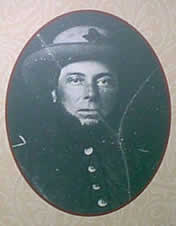
Captain Marcus (Marquis) LaFayette Redd of Onslow County
Captain of the Onslow Greys, which became Company E, Third Regiment North Carolina Troops. He was later
detached from military service for salt production along the coast. Born at Stump Sound 15 November 1824, he was
the son of Sigley (1785-1867) and Susan Annie Anders (1802-?) Redd. Died 13 March 1871. Redd is buried in thev Redd-King Cemetery, Topsail Township. He married Emily A. Sidbury on 8 October 1846. the Redd Plantation was located
near modern-day Holly Ridge, on the mainland opposite Topsail Island.
The Third North Carolina Regiment’s patriotic beginnings went back to 16 January 1776 when it was raised
at Wilmington with Colonel Jethro Sumner at its head, and fighting at Charleston, Brandywine and Germantown
with Washington’s army. The Third Regiment of 1861 was organized in May 1861 at Garysburg commanded by
Col. William Lord DeRosset and Lt. Col. Gaston Meares and Major Stephen D. Thruston of Wilmington; it included
men from Onslow, Greene, Duplin, Cumberland, Bladen, New Hanover and Beaufort Counties. The Regiment fought
from the Seven Day to Cold Harbor; marched with General Early in the Shenandoah Valley, Beaver Dam Creek,
Malvern Hill, Sharpsburg, Fredericksburg and Chancellorsville; lost 40% casualties at Gettysburg, and fought to the
end at Mine Run through Appomattox.
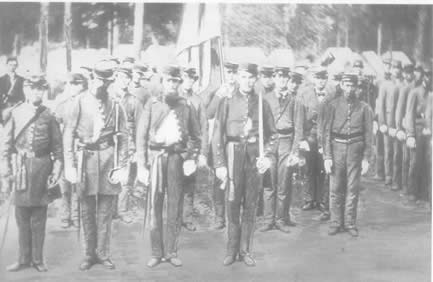
The Duplin Greys of Captain Claudius Denson
Duplin County supplied many men from Duplin Roads (now Wallace), Kenansville, Warsaw, Magnolia and Faison
who fought in Virginia as well as in the fortifications around Wilmington and Forts Fisher and Anderson on the
Cape Fear River. Among the first units formed as local militia were the “Spartan Band” of Captain A.G. Mosely
(later Company A, 38th North Carolina); the “Duplin Rifles” (organized at Kenansville in 1859, later in the 12th and
48th North Carolina Regiments) under Captain Thomas S. Kenan; the Duplin Stars which became Company C,
51st North Carolina; the Duplin Turpentine Boys which became Company E, 30th North Carolina; and the
“Confederate (Duplin) Greys” under Captain Claudius B. Denson, originally of Suffolk, Virginia. His officers
were Giles H. Watson, James H. Doshier, Robert P. James, Lewis T. Hicks,
Lemuel W. Hodges and John Franklin Ireland.
The "Duplin Greys" was a unit largely composed of students at the Franklin Military Institute near Faison,
founded by Denson in 1858 and the first military school in North Carolina. It was among the first to offer
services in defense of North Carolina to Governor John W. Ellis, and it was equipped by “company members,
families and patriotic friends.” The “Duplin Greys” eventually became Company E of the 20th North Carolina
Regiment under Colonel (later General) Alfred Iverson and Colonel Frank J. Faison of Duplin. The 20th and
fought at Malvern Hill, Seven Days, Mechanicsville, Cold Harbor, South Mountain, Fredericksburg,
Chancellorsville, Gettysburg, the Wilderness, Spotsylvania, Petersburg and the Shenandoah Valley.
In fierce battle at Gettysburg on the first day, the 20th North Carolina Regiment lost every officer killed,
wounded or captured (of 24 being present), and only 16 men of the regiment led
by Lt. John Franklin Ireland marched away from Gettysburg.
The names of the officers and soldiers of the Duplin units include: Hicks, Sprunt, Oliver, Grimes, Blalock,
Carr, Kornegay, Wright, Barfield, Brinson, Brock, Branch, Davis, Farrior, Faison, Futrall, Grady, Hall, Huggins,
Kellit, Kenan, Lanier, Outlaw, Padgett, Rogers, Strickland, Swinson, Southerland, Tew, Wallace, Westbrook
and Winders. Additionally, many Duplin men served in the “Herring Artillery” under Captain William A. Herring
in Company I of the 2nd North Carolina Artillery serving at Fort Johnson in Smithville.
Lieutenant Robert B. Carr of Duplin County was wounded at Gettysburg and captured along with Col. Thomas S. Kenan;
Carr became one of the “Immortal 600” Southern officers used as human shields in front of Northern artillery batteries at
Charleston in 1864. Nearly starved by his captors, he finally died on July 3, 1865 of chronic intestinal disorders.
Both of his brothers, Joseph and John Carr, were killed in the war.
After the war, Captain Denson of the Duplin Greys opened the Pittsboro Scientific Academy in Chatham County,
and in 1887 relocated to Raleigh where with Professor Hugh Morsen founded the Raleigh Male Academy,
and served as president of the North Carolina Teachers’ Assembly, and secretary of the State Board
of Charities. One of his main interests was an effort to establish a reformatory for young criminals in
North Carolina, and this led to the Stonewall Jackson Training School at Concord, North Carolina
which opened six years after his death, which occurred in 1903.
Sources:
Historical Essays, Cape Fear Historical Institute, www.cfhi.net
Dictionary of North Carolina Biography, William S. Powell
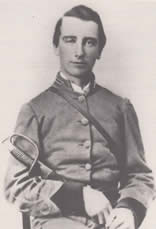
Frederick Albert Tobey: 58th North Carolina
Born in Livingston County, New York, 6 September 1842, Tobey came south with
his family in 1850 and settled in Avery County – near present-day Ingalls.
He enlisted at age 19 in the “Mitchell Rangers” on 31 December 1861, a unit known as Captain John
Boynton Palmer’s Company, North Carolina Volunteers. The Mitchell Rangers consisted of men from
Mitchell, Yancey, Watauga, Caldwell, McDowell and Ashe counties.
The Company A of which Tobey was part was a mixed unit of cavalry and infantry known as “Palmer’s Legion,”
but divided into respective infantry-cavalry commands in May 1862. Palmer was a wealthy farmer in Mitchell
County at the outbreak of war, and native of Plattsburg, Clinton County, New York. Palmer is pitured below.
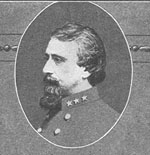
Tobey mustered in as Sergeant, was elected second lieutenant on 10 June 1862, and promoted to captain
on 11 July, 1863. In July of 1862, Company A, still under Palmer’s command, was mustered into the
58th North Carolina Regiment. The 58th North Carolina participated in the many campaigns of the
Army of Tennessee from Chickamauga to Atlanta under General’s Johnston and Hood, later in action along
the Edisto River to threaten Sherman in South Carolina, and then to Bentonville in
General Joseph E. Johnston’s army.
At Bentonville, it was noted that the 58th North Carolina came “within 200 yards of the enemy’s
first line of works, which were at once charged and carried. The command did not halt there, but moved
forward in double-quick, pursuing the enemy, flying in disorder and confusion to their second line of works,
which was also charged and carried, capturing one piece of artillery near the second line.”
Captain Tobey died on 24 November 1924 and is buried at Hollybrook Cemetery in Lincolnton.
Sources:
Genealogy online
North Carolina Troops, 1861-1865
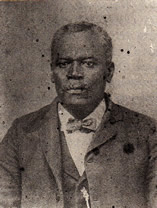
Benjamin H. Gray, CSS Albemarle
Benjamin H. Gray enlisted at age twelve for service as a seaman in the Confederate Navy,
Wilmington Squadron. Wilmington was an important center of naval activity to defend the Cape Fear region,
and where three ironclads were eventually built: CSS North Carolina, CSS Raleigh,
and the unfinished CSS Wilmington.
Gray was assigned in spring 1864 to the ironclad ram CSS Albemarle, constructed at Edwards Ferry,
near Scotland Neck. Under the command of Captain John W. Cooke, he served as a powder boy carrying bags
of gunpowder from the lower magazine to the gun deck.
While Gray was a combat veteran aboard the Albemarle, other black men like Edward Walsh of Bermuda
served on the blockade runner Eugenie making trips between Bermuda and Wilmington; and later the runners
Flora, Index, Elsie, Constance and Annie. By the end of the war Walsh had run the blockade 16 times, had two
ships sunk under him, and two more captured by Northern blockaders.
Gray was following a tradition of black crewman aboard Confederate fighting vessels. Launched at Charleston
in August 1862, the CSS Chicora’s crew included three enlisted free Negroes. Dr. Edward Smith, dean of
American Studies at American University, estimated that by February, 1865, 1150 black seamen were in
service in the Confederate Navy which amounted to about 20% of total naval personnel.
In June 1917, while a resident of Bertie County NC, Gray applied for a Confederate Pension from North Carolina.
It was approved the following month. After his death in 1924, his widow, Margaret was granted
a pension based upon his service.
Sources:
Rogues & Runners, Bermuda and the American Civil War, Catherine Deichmann
Charleston at War, 1860-1865, Jack Thomson
Cape Fear Historical Institute, Black Soldiers in Grey, Blue and Red. www.cfhi.net
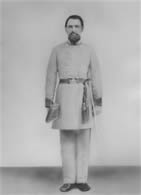
Major James Martin Stevenson of Craven County
James M. Stevenson, born in Craven County, entered the Confederate States army early in the war as
a first lieutenant under Captain John J. Hedrick’s Cape Fear Light Artillery. Hedrick led the seizure of
Forts Johnston and Caswell at the mouth of the Cape Fear River on 16 April, 1861, and Lt. Stevenson
was ordered to Fort Caswell as ordnance officer.
While there, three young Sampson men raised a company in their native county and offered
Stevenson the captaincy, which he accepted. This company was attached to the 36th North Carolina
Regiment and ordered to newly-constructed Fort Fisher, where Stevenson was promoted to the rank
of major. Known as 2nd Company A, or “King’s Artillery,” after Stevenson’s promotion to major the
company command fell to Lt. Robert Murphy of Sampson County,
and thence known as “Murphy’s Battery.”
On November 22, 1864 he was ordered to take five batteries of the Thirty-sixth Regiment to Augusta,
Georgia; they were subsequently engaged in December at Harrison’s Old Field fourteen miles from
Savannah. In opposing Sherman’s advance to Savannah, Stevenson’s contingent of the Thirty-sixth
North Carolina was commended for bravery and in covering General William Hardee’s
retreat toward North Carolina.
Stevenson returned to Fort Fisher to command his regiment and arrived just after the first enemy attack
in December 1864. On the 13th of January, 1865, the attack was renewed and in the battle Major Stevenson
was hurled from the parapet by the explosion of an eleven-inch shell. Near-paralyzed and bleeding, he was
captured and imprisoned at Fort Columbus, Governor’s Island, New York,
where he died of his wounds on February 18.
James C. and Daniel S. were worthy sons of Major Stevenson, both entering the army when they
were under the service age limit. James served on the North Carolina steamer Advance, and afterwards
joining Company A. Thirty-sixth North Carolina. He survived the war and was for many years a prominent
Wilmington merchant. Daniel entered the Confederate Signal Corps and was detailed to service on
blockade runners. He was captured by the enemy in 1865 off Galveston and imprisoned until the
end of hostilities. He died shortly after the war.
Sources:
Chronicles of the Cape Fear, James Sprunt, Edwards & Broughton, 1916, pp. 280,362-363
North Carolina Troops, 1861-1865, A Roster, Vol. I, Artillery, Louis Manarin, NC Archives & History, 1988
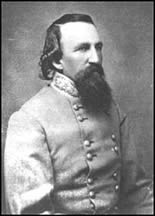
Brigadier-General James Byron Gordon
“[James B. Gordon] was born [November 21, 1822] in Wilkes County – “the State of Wilkes” –
in Western North Carolina. He is not to be confused with General John B. Gordon, of Georgia,
a distant kinsman. His forbears were Scotch-Irish pioneers, members of a large migration that
swept South in colonial days and occupied the valleys among the foothills of the Blue Ridge.
Here came the Jacksons, the Gordons, the Breckinridges, the Polks, the Prestons,
and many other shining names.
Jim Gordon, as his family and friends called him, grew up and inherited lands in the Yadkin Valley –
the same valley that was long the home of Daniel Boone and from which he and his friends and kinsmen
set out on their famous trek to Kentucky. In the eyes of the simpler mountain folk, Gordon was a
personage. He too liked to think of himself as the lord of the manor, surrounded by the mountaineers
as his retainers, after the tradition of his ancestors across the water.
As the years rolled quietly on and he found himself a bachelor of forty, life began to lose its flavor.
Perhaps he grew tired of it all. One crop of corn was like another. The Yadkin became just
another river. His retainers, when fully exposed to light, turned into barefoot hillbillies from up the
creek; so when the snows set in, he was accustomed to go every winter down to Charlotte
in search of amusement. Cards and whiskey were not neglected.
Then came 1861. Something in his blood flamed at the call to arms. He stemmed from the
Scottish Gordons, whose name sounded of fight for hundreds of years along the Border or wherever
else in the world there was fighting to be done. He telegraphed the governor of the State, offering his services.
Turning his personal property into cash, he used the money to equip a cavalry troop; his rich
bottom lands he divided among his sisters. “I do not expect to get back,” he said.
He proved to be an expert cavalryman. His old troopers in the mountains have told me that.
John Esten Cooke, a war novelist, speaks of him in the somewhat exaggerated language of that
day as “the peerless Gordon.” He was killed, with Stuart, in a cavalry charge
[at Yellow Tavern/Meadow Bridge on May 18] 1864 when
Sheridan was pressing down upon Richmond.
When Stuart was mortally wounded, the command in the field devolved upon Gordon, but when
the order reached him, he was dead. Such a death was the last gallant gesture of a dying civilization –
a civilization not without its faults but one that still flares in the imagination.”
General Gordon is buried in St. Paul’s Episcopal Cemetery at Wilkes County, North Carolina.
(Son of Carolina, Augustus White Long, Duke University Press, 1939, pp. 43-44)
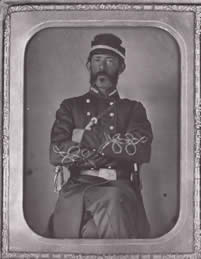
Lieutenant-Colonel James T. Weaver, 60th North Carolina
James Thomas Weaver was born in Buncombe County on November 30, 1828. He was a farmer
by occupation before enlisting in the Buncombe Light Artillery during the winter of 1861-62.
This unit was mustered in as “First Company,” McDowell’s Battalion North Carolina Infantry
(known also as the 6th Battalion North Carolina Infantry) on April 12, 1862 at Asheville.
It was redesignated the 60th North Carolina Regiment on October 8, 1862.
Weaver was elected 2nd Lieutenant on April 12, 1862, and had advanced to Captain on March 1, 1863 –
He was appointed Major and transferred to regimental staff in October 1863, due to his
“cool and gallant conduct in the late battle of Chickamauga.” He was promoted to
Lieutenant-Colonel on December 23, 1863, and assigned to conscription
duty in North Carolina through the end of February 1864.
Returning fro duty with his regiment, Weaver was killed in action during General Nathan Bedford Forrest’s
attack upon the enemy at Murfreesboro, Tennessee on December 7, 1864. Captain Thomas Patton
of Company C wrote of Weaver: “How often when the balls were thickest and the shells
shrieked the loudest, have we heard his voice….”Steady boys, there’s no danger….”
[H]e was the most perfectly cool, self-possessed man I ever saw.”
Source: NC Troops, 1861-65, A Roster, Vol. XIV, Infantry, Weymouth T. Jordan, NCDA&H, 1998
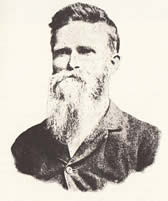
Lieutenant J.A. Spencer of Randolph County
J.A. Spencer was born in Randolph County, N.C., December 25, 1840; and died in January, 1905. In his veins
flowed the blood of those heroes in America who were the first to resist the tyranny of Great Britain, and who
under Herman Husbands fought the Battle of [Alamance], May 16, 1771, and changed Cornwallis’s victorious
advance to a hasty retreat at Guilford C.H. This soil enriched by the martyr’s blood produced brave men,
worthy sons of noble sires, and in the gage of battle between the North and South these sons were early
marshaled beneath the folds of the Stars and Bars.
Comrade Spencer served with Company F, 46th North Carolina Regiment from its organization
[at Camp Mangum], in March 1862, to the end at Appomattox. [The Regiment recruited men from
Robeson, Rowan, Burke, Warren, Richmond, Granville, Moore, Randolph, Sampson and Catawba counties.
Regimental commanders were Colonel Edward D. Hall of Wilmington and Lt. Col. William A. Jenkins
of Warrenton, former Attorney General of North Carolina].
[Lt. Spencer] attained the rank of first lieutenant. Endowed with a bright mind, a cheerful disposition, unfailing
humor, and a courageous soul, he was a universal favorite with his comrades, and by his exalted
sense of duty and devotion he attracted their attention and commanded their respect and confidence.
He was in many of General Lee’s battles except Gettysburg, [General John R.] Cooke’s [North Carolina] Brigade
being held to protect Richmond. No regiment went beyond the 46th on the battlefield, and its flag was
never lowered until the curtain went down on the last act of that great drama on the 9th of April, 1865.
He bore bravely the agony of defeat, and with tears for the friends left on numberless battlefields
he turned his face to the future, trusting in the God who had brought him safely through the dangers
of those years of war, and with his surviving comrades began to build up the impoverished South.
He engaged in merchandising, in which he was very successful.
For forty-eight years Comrade Spencer was a member of the Church, and at his death there passed
one who had lived not for this life alone.”
(The Last Roll, Confederate Veteran, August 1905, page 373)
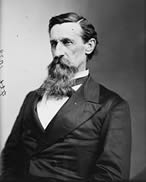
Representative James Madison Leach of Randolph County
While Jefferson Davis of Mississippi pleaded in the United States Senate for his elected
colleagues to help save the Union in January, 1861, Congressman James M. Leach pleaded in the
House of Representatives for peaceful settlement of the secession crisis, and rightly pointed to the
North’s responsibility for the condition of the country. His respected desire for peace underscores
the fact that North Carolina was indeed a “State forced out of the Union.”
Leach, born on his family homestead in Randolph County, “Lansdowne,” graduated from Caldwell
Institute in Greensboro, and from West Point in 1838. Studying the profession of law afterward, he
was admitted to the North Carolina bar in 1842 and opened his practice in Lexington. He was elected
to the Thirty-sixth Congress from North Carolina and served from March 4, 1859 until March 3, 1861.
During the War, Leach served as captain and lieutenant-colonel of the Twenty-first North Carolina
Regiment and saw action during Stonewall Jackson’s Valley Campaign, the Peninsula Campaign
under General Robert E. Lee, and Gettysburg where his regiment assaulted Cemetery Hill. He later
served in the Confederate States Congress in 1864 and 1865. Leach died in Lexington
on June 1, 1891 and is interred in Hopewell Cemetery, near Trinity, North Carolina.
(North Carolina in 1861, James H. Boykin, Bookman Associates, 1961, pp. 149-152)
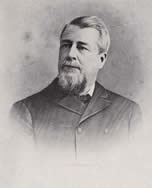
Col. Roger Moore of Wilmington
The son of Roger and Ann Sophia (Toomer) Moore, Col. Roger Moore was born on
July 19, 1838 in New Hanover County. The first conspicuous American of his lineage was
James Moore, a grandson of Col. Roger Moore of the Irish Rebellion. James Moore, born in
Ireland in 1640, emigrated to America in 1665 and settled upon his grant of land in the
Goose Creek part of the colony. He was appointed governor of North Carolina in 1700.
His son Roger became a member of the Colonial Assembly, 1738-39, and known as “King Roger” due
to his kingly bearing and unflinching courage in driving virtually all Indians from the surrounding countryside.
He was for many years a member of Royal Governor Gabriel Johnson’s council, and built the
historic mansion “Orton” in Brunswick County.
In 1766 the Moore’s once again became conspicuous as champions of the rights of the people
by presenting Governor Tryon an assurance of the spirit of independence and armed resistance then prevailing in the colony – throughout the struggle for independence the Moore family bore and honorable part.
After assuming command of the Third Regiment, North Carolina Cavalry, the greatest
achievements of this unit were accomplished and won for him the unstinted praise and sincere
thanks of General Robert E. Lee. Under Moore, two of the most brilliant cavalry dashes were made:
that of Captain McClancey at White Oak Swamp in August, 1864, when he charged into the
Yankee lines and brought out prisoners under short range of musketry; and Sergeant Johnston of
Captain Hatchett’s Company, when he entered the Federal camp on the Warren retreat from
Bellfield in December, 1864, and made its whole circuit with a mounted squad of ten men.
Half of these daring and gallant fellows were literally chopped to pieces with axes by the
Pioneer Corps, but the survivors went ahead all the same.
After the war “did yeoman’s service as Chief of the Division of the Ku Klux Klan in Wilmington.”
Organized during Reconstruction to resist anarchy and arbitrary military rule, many members
of this Klan were loyal and devoted soldiers who had served under Colonel Roger Moore.
Col. Moore befriended a young Chinese seaman, Charlie Soong, and introduced him to the
Methodist faith, and helped him obtain his release from the American ship on which he was serving.
He advised a wartime friend, Julian S. Carr, of Soong’s intense desire for an education and Carr
made it possible for Soong to attend Trinity College in Durham and Vanderbilt University in Tennessee.
After returning to China, Soong succeeded in business and lent his influence towards the spread
of Christianity – one of his daughters became the wife of Chiang Kai-Shek, another married Sun Yat-Sen.
Col. Moore was a steward and trustee of the Methodist Episcopal Church in Wilmington. His first
marriage was to Rebecca Scott Smith, their only son and child Roger died in his fifteenth year.
On May 3, 1871, Col. Moore married Eugenie Beery, daughter of Benjamin W. & Eliza Beery.
Beery was a shipbuilder and constructed both the CSS North Carolina and CSS Wilmington at his
Eagles Island yard. Col. Roger Moore died April 21, 1900
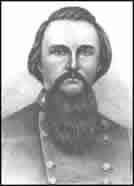
Colonel George Burgwyn Anderson:
Born near Hillsboro on 12 April 1831, oldest son of William E. Anderson, Esq., and his wife,
Eliza Burgwyn. George attained high honors and distinction at the University of North Carolina
and was appointed to West Point at age seventeen, in 1848; graduating ninth in a class of
forty-one in 1852.
In a memorial address of May 11, 1885, Hon. Alfred Moore Waddell of Wilmington stated of General Anderson:
“I am here to-day, in compliance with your invitation, to attempt to pay a tribute to the memory of
as noble a gentleman, as knightly a soldier, as true a man, and as devoted a son of North Carolina
as any who lived. Truth and manliness were his distinguishing characteristics, and to them in
whomsoever found he was ever ready to do reverence.
When George Anderson became an officer….he buckled on that sword….[and] with fervent love
and that inexorable sense of honor and duty which was the all-controlling motive of his life, he
turned to North Carolina and reverently laid it at her feet. It was an offer [by Governor
John W. Ellis] gladly accepted, and he was immediately
commissioned Colonel of the Fourth Regiment.
The battle of Seven Pines was a bloody baptism for Colonel Anderson’s regiment; indeed, it
was almost unparalleled in its terrible destructiveness to that command, for of the twenty-seven
officers fit for duty all except one were either killed or wounded, and of the five-hundred and twenty
men in the ranks, eighty-six were killed and three hundred and seventy-six were wounded, leaving
only fifty-eight out of the five-hundred and twenty unhurt – a record which is the best evidence
of the perfect discipline and splendid courage exhibited by that glorious regiment
in its first hard fight with the enemy.
During this engagement Colonel Anderson seized the flag of the Twenty-seventh Georgia and
dashed forward holding it aloft. Before their resistless sweep the stubborn foe reeled and fled,
and the colors which Anderson bore were planted on their breastworks. Such men were
worthy of being commanded by the bravest of the brave, and the cordial thanks and commendation
of a division commander, who was not given to laudation of any one, caused the immediate
recognition of Colonel Anderson’s merits by the President, who, being on the field,
at once promoted him, and his well-won commission of Brigadier-General was forwarded
and received by him on the 9th day of June, 1862.
The brigade assigned to him were all North Carolinians, being composed of the Second,
Fourth, Fourteenth and Thirtieth Regiments – as fine a body of troops as ever trod the perilous edge
of battle, and one with afterwards achieved as brilliant a reputation as the most brilliant in the Army
of Northern Virginia. Then came the Seven Days’ struggle around Richmond, in each of which the
brigade took an active part and the young brigadier won new laurels as a most gallant and efficient officer.”
At the battle of Sharpsburg and during his brigade’s assault on the enemy’s center Anderson
received a wound in the foot which would prove fatal. He was taken to Virginia -- with his
brother and aide de camp, Captain Walker Anderson, who was also wounded at Sharpsburg
and killed at the Wilderness -- to Raleigh, arriving in the latter part of September.
“His wound was a most painful one, and he suffered great agony for two weeks….Finally amputation
was decided upon, but it was too late. He sunk under the operation, and on the morning of
October 16, 1862, in the thirty-second year of his age, his brave soul bid farewell to earth.
A very large assemblage of the citizens of Raleigh gathered to give expression to their grief and
to testify their respect for his memory; his mortal remains were born to your beautiful cemetery
and tenderly and reverently laid beneath the sod where his monument now stands.
[He] died, while the banner of the Confederacy still floated triumphant in every breeze. He never
saw that banner lowered to the foe, and his proud spirit was spared the humiliation to which his
surviving comrades were afterwards subjected. The government for which he fought and died was
long since numbered with the dead empires, and the one against which he bore arms has, with
its vast powers constantly centralizing in the hands of an all-absorbing national legislature,
become the richest and most powerful on the earth.
If true manliness and an exalted sense of duty; if the strictest integrity, and the most
scrupulous regard of the rights of others; if a chivalric sentiment towards woman, and
a delicate sense of personal honor; if a commanding presence and cheerful spirit; if
dauntless courage and gentle manners; if a brilliant intellect and extensive knowledge;
and finally, if patriotic service, ending in painful wounds, heroic suffering and death – if all
these combined constitute a theme worthy of commemoration by orator or poet, then
the duty assigned me to-day might well have been entrusted to the most gifted of men,
and the people of North Carolina would have a juster estimate of the
life and services of George Burgwyn Anderson.”
(Southern Historical Society Papers, XIV, Rev. J. William Jones, editor,
January to December 1886, excerpts, pp. 391-397)
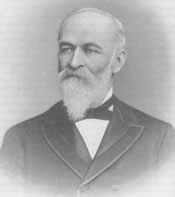
Major Charles Manly Stedman of Chatham County
Born at Pittsboro, Chatham County on 29 January 1841, his family moved to Fayetteville when he was
twelve years old. At age sixteen he entered the University of North Carolina, took first honors
in his studies, and was to be salutatorian of his class though interrupted by the war. He volunteered
as a private in the Fayetteville Independent Light Infantry; subsequently he rose to captain
of Company E (Chatham County) in the 44th North Carolina Regiment; then to
field rank of major on 28 July 1862.
Major Stedman was one of twelve North Carolina soldiers who held the distinction of fighting
in the first battle at Bethel Church and who ended the war with Lee at Appomattox. He was wounded
three times and distinguished himself at Chancellorsville, the Wilderness, and Ream’s Station in late
August 1864 when four North Carolina brigades assaulted, and, virtually unaided, drove Warren’s Corps
in a complete rout from behind their breastworks.
After the war he returned to Chatham County to teach, studied law under John Manning, and moved to
Wilmington in 1867 to practice law. There he married Miss Catherine Wright in 1866, daughter of
Joshua Grainger Wright. Major Stedman was elected as Lieutenant-Governor in 1884 and served
1885-1889; he ran unsuccessfully for governor in 1890 when he lost to Judge Fowls. Due to poor health,
Stedman moved to Asheville in 1891.
Major Stedman also served president of the North Carolina Bar Association, director of the North Carolina
Railroad, and Trustee of the University of North Carolina. He was among the original charter members
of Wilmington’s distinguished Cape Fear Club, incorporated in 1872 and still in operation today
.
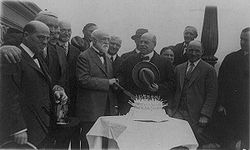
In 1910 he was elected to Congress from the Fifth District where he served continuously until his death on
23 September, 1930. At the time of his death at 89 years, Major Stedman was the last Confederate officer
serving in the United States Congress. His body was laid to rest with full military honors in
Cross Creek Cemetery in Fayetteville.
Mr. A. Wayland Cooke said of Major Stedman in 1914, nominating him for a third term:
“If I were to name his greatest traits of character I should say that they were his constant and unswerving
adherence to duty, his absolute fearlessness and fortitude, his eminent truthfulness and his fidelity to
his friends….he is one of the highest type of men the State of North Carolina has ever produced.
I commend to you as a soldier of the South who was first at Bethel, four years in the service without
a furlough, and who laid down his arms with Lee at Appomattox, and the officer
of the Southern army now in Congress.”
(North Carolina, Rebuilding an Ancient Commonwealth, Vol. III, American Historical Society, 1928,
pp. 550-551; Confederate Veteran, November 1930, page 414)
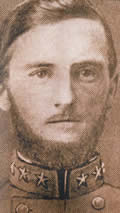
Col. Hector McAlester McKethan of Cumberland County
The son of Alfred Augustus and Loveday Campbell McKethan, he was born 15 September 1834
in Cumberland County His mother was the daughter of Reverend James Campbell of Pennsylvania.
A prosperous carriage maker in his father’s Fayetteville business prior to 1861, Hector entered the service
of his State as a member of the Fayetteville Independent Light Infantry, (FILI), with the rank of lieutenant.
Engaged at Bethel Church in Virginia with Company H (FILI) of the First North Carolina Volunteers
under Captain Wright Huske, McKethan later served as Colonel of the 51st North Carolina
Regiment which was organized at Wilmington in April, 1862.
The 51st was comprised of men from New Hanover and Brunswick, the “Warsaw Sampsons” from Duplin
and Sampson counties, the “Duplin Stars,” Robeson county’s “Scotch Tigers,” the “Clay Valley Rangers”
and “Ashpole True Boy”s of Robeson county, the “Columbus Light Infantry”, and Sampson’s “Confederate Stars.”
Commanded by Col. John Lucas Cantwell of Wilmington, the regiment saw action in South Carolina
at Battery Wagner; in Virginia at Petersburg, Second Cold Harbor, and Fort Harrison, where
McKethan received a serious wound.
After the Battery Wagner battle, McKethan wrote:
“[Our] line was unbroken during the entire fight, and was successfully defended from three separate
assaults made on it by the enemy, and their dead and wounded are the surest evidence of the precision
with which we fired. The first assault [led by the 54th Massachusetts Regiment [colored] was made
about 8 PM…the enemy was three times repulsed from the front of my line, [I] directed my fire to
rake the ditch and the outer portion of the work at that point, and am convinced that our fire
must have been very destructive….the action continued until 11:30PM, when the firing ceased.
[My heavy loss is an evidence of the readiness with which the men exposed themselves.”
At Petersburg in June of 1864, McKethan’s 51st North Carolina formed part of the 15,000 Southern
soldiers defending the city against 75,000 enemy troops – Clingman’s Brigade is credited with helping
to seal a dangerous enemy penetration of the line with a bayonet charge and hand to hand fighting
with muskets used as clubs.
He succeeded Col. Cantwell to regimental command, and then assumed command of Gen. Thomas
Clingman’s Brigade under Gen. Robert F. Hoke during the campaign from Fort Fisher, to Southwest
Creek and Bentonville. It was Col. McKethan and Clingman’s Brigade at the battle of Forks Road
below Wilmington who helped repulse three enemy assaults; the latter got no closer
than 150 yards from McKethan’s line.
Col. McKethan returned to the old Fayetteville home of his parents where he lived unmarried until his
death on 6 November 1881. He is buried in Cross Creek Cemetery, Fayetteville.
His obituary from the Laurinburg Enterprise reads:
“Death of Col. Hector McKethan, the brave commander of the
51st N.C. Regiment…died at the residence of his father in Fayetteville last Sunday afternoon.
He was a brave soldier, a discreet and valiant commander, and distinguished himself on many
a bloody battle field. Having the esteem of his soldiers, they followed his lead and obeyed his
command with a readiness which fully attested their devotion….More than once did he return
from bloody contests with but a small number of those courageous fellows who entered with him.
Brave and generous as he was, he is gone. Peace to his ashes; and may his surviving comrades,
who laid him to rest at the tomb with military honors, see that his grave is kept green!”
(Sources: USGenWeb Archives; 51st NC Regimental History, A.A. McKethan)
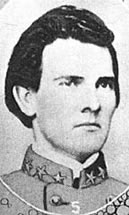
Edwin Augustus Osborne: Confederate Colonel, Minister, Humanitarian
Born in a Moulton, Alabama log house on 6 May 1837, he was one of eleven children of Ephraim Brevard
and Nancy Smith Osborne and named for his paternal uncle Edwin, and for General John Augustus Young.
Osborne’s great-grandfather Alexander was born in New Jersey but moved to Salisbury, North Carolina
about 1754 and later in Iredell County.
Edwin’s grandfather Adlai was one of the first trustees of the University of North Carolina, his father
was a physician who fought with General Andrew Jackson – one of the few to escape from Indian
massacre at Fort Mims and with Jackson at New Orleans.
Edwin returned to North Carolina to live with his widowed Aunt Peggy on her Mecklenburg County
plantation, and she arranged for his schooling at the Statesville Military Academy in 1859. After
enlisting for Confederate service with the northern Iredell County “Hunting Creek Guard” in
June 1861, he was elected captain of Company H, Fourth Regiment, North Carolina Troops and
fought at Yorktown, Williamsburg and Seven Pines, where he was wounded in 1862. Here, while
his company was unsupported and facing certain destruction form enemy fire, he ordered a charge
which drove the enemy and captured six pieces of artillery.
He saw further action at South Mountain and Sharpsburg, where he was wounded again, then
to Chancellorsville, Gettysburg, Spottsylvania and the Wilderness which left him injured again, and
with Lee at Appomattox. During his time in action he was promoted to major, lieutenant-colonel,
and eventually colonel, leaving his regiment only to recover from the frequent wounds.
Returning home suffering from fever and nothing but his horse and missing two fingers on one hand,
he joined his wife and mother in law at the latter’s home in Statesville.
Edwin taught school in Statesville and later in Charlotte, where he studied law and was admitted to the bar.
Appointed Clerk of Superior Court in 1867 and re-elected twice, he held the position for ten years.
He joined his wife’s Protestant Episcopal church in 1874 and soon decided to enter the ministry,
being ordained deacon on 3 June 1877 and named rector of Calvary Church in Fletcher.
In 1884 he was appointed to St. Mark’s and St. Paul’s missions in Mecklenburg County where under
his leadership both received new church buildings. He also added a black congregation, St. Michael’s
and All Angels, in Charlotte. In addition, his concern for orphans led to the opening of Thompson
Orphanage and Training Institution on 10 May 1887.
When war broke out with Spain in 1898, Osborne resigned from the orphanage to serve as Chaplain
of the Second Regiment of North Carolina Volunteers and remained on active duty for the duration of the war.
Osborne was “Noted for his gentle spirit, chivalry, bravery, and idealism. Very much affected by his [War]
experiences, he wrote poetry in a diary he had kept during the war. Years later he reflected that one year,
on the first day of July, he had noticed a feeling of sadness coming over him, then remembered that
it was the anniversary of Gettysburg. For a time Osborne was the chaplain of
the Mecklenburg Camp of Confederate Veterans.
Edwin Augustus Osborne died at age eighty-nine after a period of declining health, and was
buried in Charlotte’s Elmwood Cemetery.”
(Source: Biography of Edwin Augustus Osborne, Dorothy H. Osborne, Dictionary of North Carolina Biography,
William S. Powell, editor, UNC Press, 1987, pp. 401-402)

Copyright 2012 The North Carolina War Between the States Sesquicentennial Commission